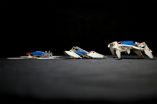(Press-News.org) As the complex story of climate change unfolds, many of the endings are grim. But there are exceptions. Predictions that the lowest-oxygen environments in the ocean would get worse may not come to pass. Instead, University of Washington research shows climate change, as it weakens the trade winds, could shrink the size of these extreme low-oxygen waters.
"The tropics should actually get better oxygenated as the climate warms up," said Curtis Deutsch, a UW associate professor of oceanography. He is lead author of the study published Aug. 8 in Science.
Warmer water contains less gas, so climate change is expected to reduce oxygen levels worldwide. Observations show this is already taking place in many places. Declines during the past 20 years in the tropical low-oxygen zones, the lowest-oxygen waters on the planet, had led to a 2008 study proposing that these zones would also get worse over time.
Tropical regions are usually associated with an abundance of life, but they have some of the most inhospitable places for ocean dwellers. The oxygen minimum zones off Mexico and Peru have oxygen levels already too low to support most animals (so, unlike in other low-oxygen zones, here there's no risk of killing fish).
But when those levels drop even further, a particular group of bacteria, which can use nitrogen instead of oxygen as a source of energy, thrive. Nitrogen is an essential and very scarce nutrient for marine plants. When oxygen levels get low enough for that particular group of bacteria to take over, significant amounts of the ocean's fertilizer get deep-sixed to the bottom of the tropical ocean.
The new paper shows that water flowing into the tropics is indeed likely to get lower in oxygen, decreasing the initial oxygen supply. But demand will also shift under climate change. Specifically, as the trade winds weaken, the whole sequence of events that feeds this bacterial food chain will slow down, and the low-oxygen zone will shrink.
"If we want to understand how biological and chemical aspects of the ocean will change in the future, we really have to pay a lot of attention to what happens with the winds," Deutsch said. "The winds can lead to conclusions that are exactly the opposite of what you'd expect."
Trade winds from the west cause deep water to percolate up along western coasts, bringing nutrients up from the deep sea. These nutrients feed marine plants, which feed marine animals, which decompose to feed bacteria that use up the remaining oxygen. As trade winds weaken, less nutrient-rich water percolates up from the deep. Fewer plants grow at the surface. Finally, fewer oxygen-gobbling bacteria can survive.
Deutsch is a climate modeler who studies tropical ocean circulation. He learned of sediment cores, collected off Mexico by co-authors William Berelson at the University of Southern California and Alexander van Geen at Columbia University, that showed a puzzling longer-term trend. The authors worked together to interpret the samples. Results show that for most of the time since 1850 the population of these nitrogen-eating bacteria has been going down, coincident with warming oceans and weakening trade winds. This implies that the local oxygen levels, for which few direct measurements exist, have been rising.
"I find it an interesting question for understanding the way the ocean functions on climatic or geologic timescales," Deutsch said.
Most climate models predict that trade winds will continue to weaken in the future, shrinking the oxygen-minimum zones in the Pacific Ocean off the coasts of Mexico, Chile and Peru, and in the Indian Ocean off western Australia.
Decreasing oxygen in the wider ocean is still a major concern, Deutsch said, as are overfishing, ocean acidification and warming water temperatures.
"This study shows that what happens to the winds, which is sometimes overlooked, is really important for predicting how the oceans will respond to climate change," Deutsch said.
INFORMATION:
The research was funded by the National Science Foundation, the Gordon and Betty Moore Foundation, the U.S. Geological Survey and the Lamont-Doherty Earth Observatory. Other co-authors are Tom Weber, a research scientist at the UW; Robert Thunell at the University of South Carolina; Caitlin Terms at the University of Southern California; James McManus at the University of Akron; John Crusius at the U.S. Geological Survey; Taka Ito at the Georgia Institute of Technology; Timothy Baumgartner and Vicente Ferreira at Mexico's Autonomous University of Baja California; and Jacob Mey at the City University of New York.
For more information, contact Deutsch at 206-543-5189 or cdeutsch@uw.edu.
Ocean's most oxygen-deprived zones to shrink under climate change
2014-08-07
ELSE PRESS RELEASES FROM THIS DATE:
Water 'microhabitats' in oil show potential for extraterrestrial life, oil cleanup
2014-08-07
PULLMAN –An international team of researchers has found extremely small habitats that increase the potential for life on other planets while offering a way to clean up oil spills on our own.
Looking at samples from the world's largest natural asphalt lake, they found active microbes in droplets as small as a microliter, which is about 1/50th of a drop of water.
"We saw a huge diversity of bacteria and archaea," said Dirk Schulze-Makuch, a professor in Washington State University's School of the Environment and the only U.S. researcher on the team. "That's why we speak ...
Orally delivered compounds selectively modify RNA splicing, prevent deficits in SMA models
2014-08-07
Today the journal Science published results of a preclinical study demonstrating that treatment with orally available RNA splicing modifiers of the SMN2 gene starting early after birth is preventing deficits in a mouse model of Spinal Muscular Atrophy (SMA). Scientists from Roche Pharma Research and Early Development (pRED), PTC Therapeutics, Inc., the SMA Foundation, the University of Southern California and Harvard University collaborated to demonstrate that continuous treatment of SMA mice with these compounds increased life span, normalized body weight and prevented ...
Study reveals dynamics of microbes and nitrate
2014-08-07
Human tampering with global carbon balances has received massive public attention because of its effects on global warming, but we pay less attention to another set of chemical processes we are similarly disrupting: human input to the nitrogen cycle. Unfortunately, the story of nitrogen transformations in the biosphere is also less understood.
In modern times, humans developed the technology to turn nitrogen gas in the atmosphere into a biologically available form to be used as fertilizer. Before this, bio-available or "fixed" nitrogen was only created sparingly by natural ...
Origami could lead to exotic materials, tiny transformers
2014-08-07
ITHACA, N.Y. – Embracing the pleats, creases and tucks of the Japanese art of decorative paper folding, Cornell University researchers are uncovering how origami principles could lead to exotic materials, soft robots and even tiny transformers.
Publishing online in the journal Science Aug. 8, an interdisciplinary team led by Cornell's Itai Cohen, associate professor of physics, and graduate student Jesse Silverberg have discovered how to use a well-known origami folding pattern called the Miura-ori to control fundamental physical properties of any thin sheet of material.
Video, ...
Step closer to birth of the sun
2014-08-07
Researchers are a step closer to understanding the birth of the sun.
Published in Science, the team led by Dr Maria Lugaro and Professor Alexander Heger, from Monash University, have investigated the solar system's prehistoric phase and the events that led to the birth of the sun.
Dr Lugaro, from the Monash Centre for Astrophysics, said the team used radioactivity to date the last time that heavy elements such as gold, silver, platinum, lead and rare-earth elements were added to the solar system matter by the stars that produced them.
"Using heavy radioactive nuclei ...
Finding the genetic culprits that drive antibiotic resistance
2014-08-07
Researchers have developed a powerful new tool to identify genetic changes in disease-causing bacteria that are responsible for antibiotic resistance. The results from this technique could be used in clinics within the next decade to decide on the most effective treatments for diseases such as pneumonia and meningitis.
The team looked at the genome of Streptococcus pneumoniae, a bacterial species that causes 1.6 million deaths worldwide each year. In the most detailed research of its kind, scientists used a genome-wide association study (GWAS) to locate single-letter ...
Learning from origami to design new materials
2014-08-07
AMHERST, Mass. -- A challenge increasingly important to physicists and materials scientists in recent years has been how to design controllable new materials that exhibit desired physical properties rather than relying on those properties to emerge naturally, says University of Massachusetts Amherst physicist Christian Santangelo.
Now he and physicist Arthur Evans and polymer scientist Ryan Hayward at UMass Amherst, with others at Cornell and Western New England University, are using origami-based folding methods for "tuning" the fundamental physical properties of any ...
Robot folds itself up and walks away
2014-08-07
A team of engineers used little more than paper and Shrinky dinks™ – the classic children's toy that shrinks when heated – to build a robot that assembles itself into a complex shape in four minutes flat, and crawls away without any human intervention. The advance, described in Science, demonstrates the potential to quickly and cheaply build sophisticated machines that interact with the environment, and to automate much of the design and assembly process. The method draws inspiration from self-assembly in nature, such as the way linear sequences of amino acids fold into ...
Origami robot folds itself up, crawls away
2014-08-07
For years, a team of researchers at MIT and Harvard University has been working on origami robots — reconfigurable robots that would be able to fold themselves into arbitrary shapes.
In the August 7 issue of Science, they report their latest milestone: a robot, made almost entirely from parts produced by a laser cutter, that folds itself up and crawls away as soon as batteries are attached to it.
"The exciting thing here is that you create this device that has computation embedded in the flat, printed version," says Daniela Rus, the Andrew and Erna Viterbi Professor ...
NASA sees heavy rainfall in Iselle as the hurricane nears Hawaii
2014-08-07
VIDEO:
TRMM satellite rainfall data overlaid on an enhanced infrared image from NOAA's GOES-West satellite shows heavy rainfall occurring around the Iselle's eye. The most intense rain was falling at a...
Click here for more information.
A NASA satellite has observed heavy rainfall in Hurricane Iselle on its approach to Hawaii. NASA's TRMM Satellite captured rainfall rates within the storm as it passed overhead. In addition, NASA's Aqua satellite provided a larger view of the Central ...


